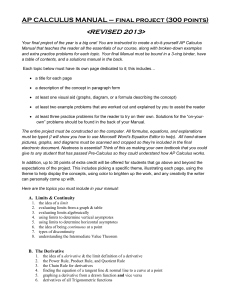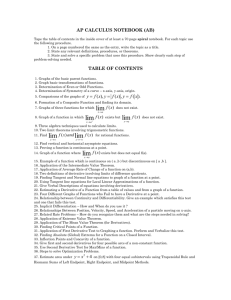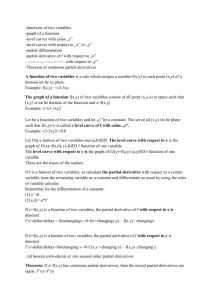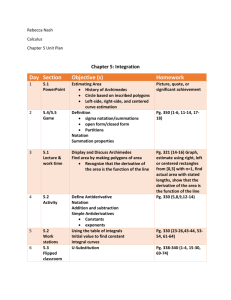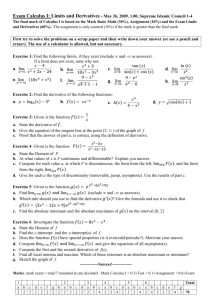Exam Review Syllabi with Note Space
advertisement
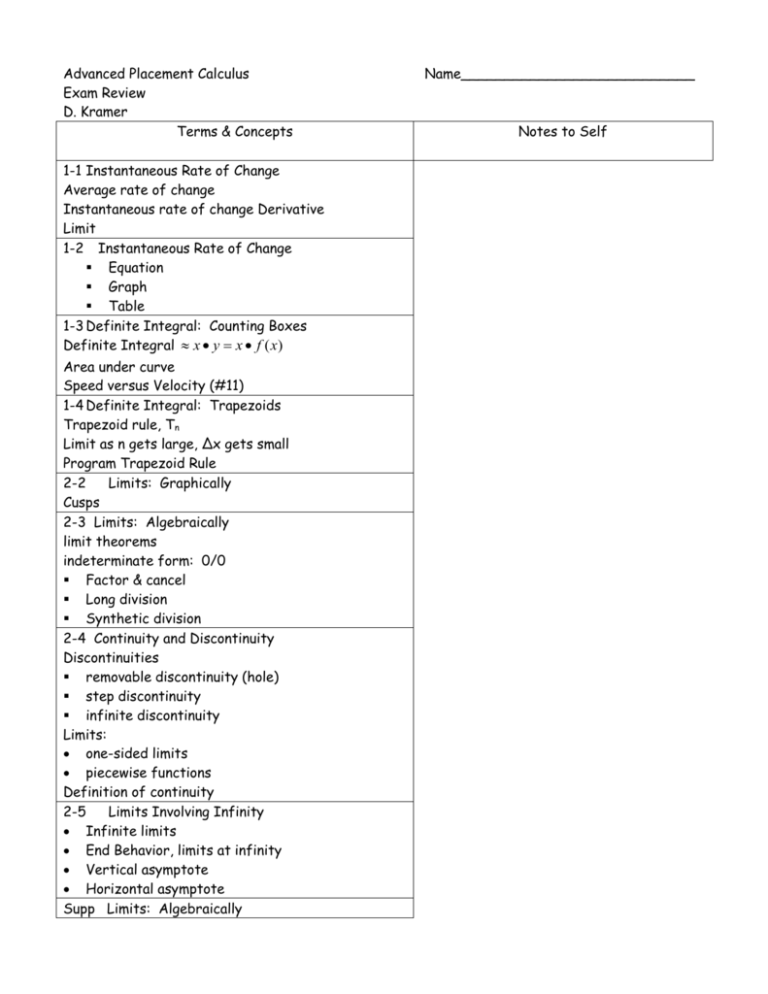
Advanced Placement Calculus Exam Review D. Kramer Terms & Concepts 1-1 Instantaneous Rate of Change Average rate of change Instantaneous rate of change Derivative Limit 1-2 Instantaneous Rate of Change Equation Graph Table 1-3 Definite Integral: Counting Boxes Definite Integral x y x f ( x) Area under curve Speed versus Velocity (#11) 1-4 Definite Integral: Trapezoids Trapezoid rule, Tn Limit as n gets large, Δx gets small Program Trapezoid Rule 2-2 Limits: Graphically Cusps 2-3 Limits: Algebraically limit theorems indeterminate form: 0/0 Factor & cancel Long division Synthetic division 2-4 Continuity and Discontinuity Discontinuities removable discontinuity (hole) step discontinuity infinite discontinuity Limits: one-sided limits piecewise functions Definition of continuity 2-5 Limits Involving Infinity Infinite limits End Behavior, limits at infinity Vertical asymptote Horizontal asymptote Supp Limits: Algebraically Name___________________________ Notes to Self 2-6 The Intermediate Value Theorem. If f is cont on [a,b] and y* is any value between f(a) and f(b), then there exists x* [a,b] such that f(x*)=y*. The Extreme Value Theorem If f is cont on [a,b] then there exist such that f( [a,b]. c1 , c2 [a,b] c1 ) is a max and f( c2 ) is a min of f on 3-1 Graphical Interpretation of Derivative 3-2 Definition of Derivative Difference Quotient f ( x ) f (c ) f ( x h ) f ( x ) xc h , , Def of Derivative: f ( x ) f (c ) x c xc f ( x h) f ( x ) f '( x) lim h 0 h f '(c) lim Equation of Tangent Line 3-3 Derivative Function Sketching f’(x) from graph of f(x) Math #8 NDeriv(function, x, x) Calc #6 dy/dx 3-4 Derivative of Power Functions Terms: differentiate, differentiable dy d d Notation: y’, dx , dx y, dx If f(x) = xn then f’(x) = _________ Theorems: Dx(f(x) + g(x)) = Dx f(x) + Dx g( x) Dx (k f(x)) = k Dx f(x) Dx ( c) = 0 Second Derivatives and Notation 3-5 Motion Problems Displacement and Distance Velocity and Speed Acceleration speeding up / slowing down Max & Min, relative & absolute 3-6 Sine and Cosine Functions Dx (sin x) = _________ Dx (cos x) = __________ 3-7 Derivatives of Composite Functions The Chain Rule: Dx f(g(x)) = __________ 3-8 Derivatives of Sine and Cosine Writing equations for sine and cosine 3-9A Exponential and Log Functions Properties : ln ab ______ ln a / b _____ ln1 ___ ln e ___ ln a n ______ ln e x ___ eln x ___ 3-9B Exponential and Log Functions Derivatives: Dx ln x _______ Dx e x ________ Dxb x ________ 4-2 Derivative of a Product Product Rule: Dx f(x)g(x) = ______________________ Simplifying 4-3 Derivative of a Quotient Quotient rule: f ( x) Dx g ( x ) = ___________________ Simplifying 4-4 Derivatives of Other Trig Functions Dx sin x =___________________ Dx cos x =___________________ Dx tan x =___________________ Dx cot x = ___________________ Dx sec x =___________________ Dx csc x =___________________ 4-5 Derivs of InverseTrig Functions Inverse Trig Summary, page 149 Dx sin-1 x =___________________ Dx cos-1 x =___________________ Dx tan-1 x =___________________ Dx cot-1 x = ___________________ Dx sec-1 x =___________________ Dx csc-1 x =___________________ Derivative of Inverse Property 4-6 Differentiabiltiy and Continuity Def: Differentiability Theorem & Sketches Supp: Conic Sections 4-7 Derivatives of Parametric Functions Parametric Equations, Parameters First Derivatives (Parametric Chain Rule) dy dx = ___________ Second Derivatives d2y dx 2 = _________________ 4-8 Implicit Relations Implicit Differentiation 4-9 Related Rates 5-2 Differential y dy x dx , y f ( x x) f ( x) dy l ( x x) l ( x) f '( x)dx error y dy 5-3 Antiderivative, Indefinite Integral Definition Notation, Integrand, Operator Constants, Sums, Differences Products 5-4 Riemann Sums: Left, Right, Midpt, Upper, Lower Definite Integral b n f ( x)dx lim f ( xk ) xk n a k 1 if this limit exists. 5-5 Integrability if continuous then integrable if bounded with finite number of discontinuities, then integrable Mean Value Theorem Rolle’s Theorem 5-6 Fundamental Theorem of Calculus FTOC Integral versus Area Exact value of an integral: b a n f ( x)dx lim f (k x) x n k 1 5-7 Properties of the Definite Integral Same integrand, different order of bounds Same integrand, different bounds Even & Odd functions Substitution 5-8 Area Between Curves Horizontal & Vertical Slices 5-9 Volume of Solids Solids of revolution Solids with Known Cross-Sections 6-2 Integrals Using ln ln x x 1 1 dt t , where x 0 1 dx ln x C Fact: x Second Fundamental Theorem x Dx f (t )dt f ( x) a , Dx g ( x) a f (t )dt f ( g ( x)) g '( x) 6-3 Derivatives of Log Functions D log x x b 6-4 Derivatives and Integrals of Logs & Exponents Logarithmic Differentiation 6-5 Limit Review L’Hospital’s Rule for 0/0 and / Indeterminate Form - Indeterminate Exponential Forms 7-2 Exponential Growth & Decay General/Particular Solution Initial Condition Other differential equations 7-4 Slope Fields Initial Conditions 8-2 First Derivative Test for Extrema Critical Point of f Increasing/Decreasing Relative/Absolute Max/Min Plateau Point Second Derivative Test for Inflection Critical Points of f ' Concavity, Inflection Cusps & Corners Average value of a function


